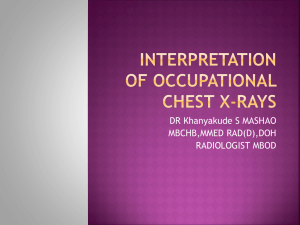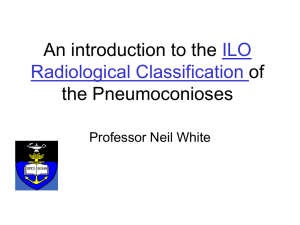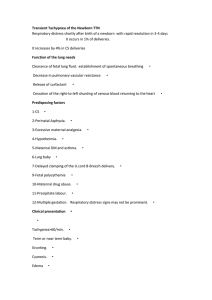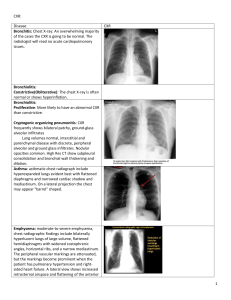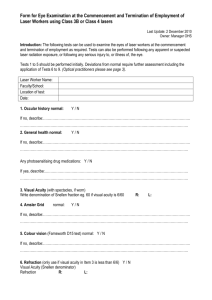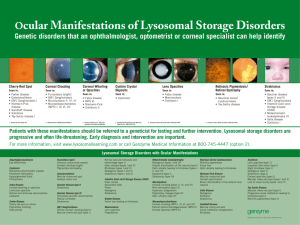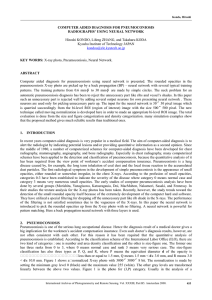Chapter 2 Coding CT-Classification in Occupational and Environmental Respiratory
advertisement
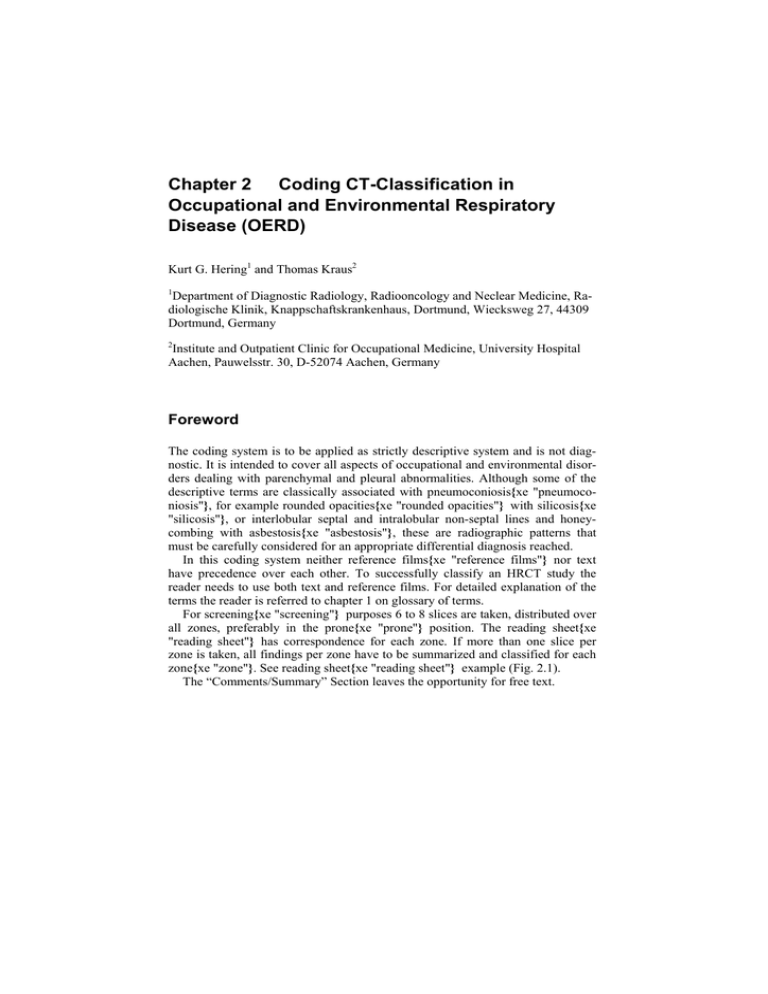
Chapter 2
Coding CT-Classification in
Occupational and Environmental Respiratory
Disease (OERD)
Kurt G. Hering1 and Thomas Kraus2
1
Department of Diagnostic Radiology, Radiooncology and Neclear Medicine, Radiologische Klinik, Knappschaftskrankenhaus, Dortmund, Wiecksweg 27, 44309
Dortmund, Germany
2
Institute and Outpatient Clinic for Occupational Medicine, University Hospital
Aachen, Pauwelsstr. 30, D-52074 Aachen, Germany
Foreword
The coding system is to be applied as strictly descriptive system and is not diagnostic. It is intended to cover all aspects of occupational and environmental disorders dealing with parenchymal and pleural abnormalities. Although some of the
descriptive terms are classically associated with pneumoconiosis{xe "pneumoconiosis"}, for example rounded opacities{xe "rounded opacities"} with silicosis{xe
"silicosis"}, or interlobular septal and intralobular non-septal lines and honeycombing with asbestosis{xe "asbestosis"}, these are radiographic patterns that
must be carefully considered for an appropriate differential diagnosis reached.
In this coding system neither reference films{xe "reference films"} nor text
have precedence over each other. To successfully classify an HRCT study the
reader needs to use both text and reference films. For detailed explanation of the
terms the reader is referred to chapter 1 on glossary of terms.
For screening{xe "screening"} purposes 6 to 8 slices are taken, distributed over
all zones, preferably in the prone{xe "prone"} position. The reading sheet{xe
"reading sheet"} has correspondence for each zone. If more than one slice per
zone is taken, all findings per zone have to be summarized and classified for each
zone{xe "zone"}. See reading sheet{xe "reading sheet"} example (Fig. 2.1).
The “Comments/Summary” Section leaves the opportunity for free text.
16
Fig. 2.1 Reading Sheet
17
Basic Data
Name/No.:
Data for Registration:
CT-Information:
Date and Number
Modality
Sequential CT{xe "CT:Sequential"}
Spiral-Single-Slice CT{xe "CT:Spiral-Single-Slice"}
Spiral-Multi-Slice CT{xe "CT:Spiral-Multi-Slice"}
No. of slices for evaluation – at least 6 reference-slices
Slice thickness{xe "Slice thickness"} – 1-2 mm
Window settings – preferably 2 window settings
Quality{xe "Quality"}:
1 = good; 2 = acceptable, with no technical defect likely to impair classification; 3 = acceptable, with some technical defect but
still adequate for classification purposes; 4 = unreadable
Position –preferably prone position at least for the 6 reference slices
The Initial or Basic question
”Is the film completely negative?”
If “Yes” just fill date and signature at the bottom of the sheet; if “No” the classification has to be done step by step for each item!
Well defined rounded opacities
Absence (No) or Presence (Yes) has to be reported.
It includes all measurable, well defined rounded opacities{xe "rounded opacities"} from <1.5 mm in diameter (= P{xe "P"}), between 1.5 and 3 mm (= Q{xe
"Q"}), to 3 up to 10 mm (= R{xe "R"}).
NOTE: It has to be remembered that hardcopy CT images are diminished and the
dimensions of opacities recorded should be true or life size measurements.
The overall distribution is recorded in a grading{xe "grading"} system, regardless of form and size, for each side right (R) or left (L) and each zone of the thorax: upper (U) – arch of the aorta{xe "arch of the aorta"} and above, middle (M) –
arch of the aorta down to the inferior pulmonary vein{xe "inferior pulmonary
vein"}, lower (L) – inferior pulmonary vein and below including diaphragm{xe
"diaphragm"}. The precise definition of the borderline of the zone is not crucial
for the application of the system.
18
0 = no definitive opacities
1 = mild, small opacities definitely present but few in number
2 = moderate, numerous small opacities
3 = severe, small opacities very numerous, normal anatomical lung structures
poorly visible
It is possible to check more than one opacity, e.g. P and Q or another combination, and then the predominant size P, Q or R has to be recorded.
Sum of grading, regardless of size, side and zone.
Possible ranging from 0 to 18.
e.g.
R– U–3
L– U–2
M–2
M–1
L–0
L–0
Sum = 8
Irregular and/or linear opacities
Absence (No) or Presence (Yes) has to be reported.
Morphologic abnormalities of parenchymal disease: Intralobular opacities,
Interlobular opacities
Intralobular opacities include dotlike lesions in early asbestosis or hypersensitivity pneumonitis. Subpleural curvilinear opacities are a specific distribution of
fibrotic intralobular core structures, paralleling the pleura, few millimetres or less
in thickness and usually 1 cm from the pleural surface and are reported as a symbol (“SC”). Parenchymal bands are peripheral linear opacities, branching from the
surface of a thickened pleura. They have to be reported with pleural abnormalities
separately as a symbol (“PB”). If there is no visible contact to the pleural surface
(maybe due to limited number of slices) they should be mentioned as translobular
bands and additional explanatory notes should be made without using a symbol.
Mark the absence (X) or presence (X) for each item and predominant type.
The overall distribution is recorded in a grading system, regardless of type, for
each side right (R) or left (L) and each zone, upper (U), middle (M) and lower (L):
0 = no definite abnormalities
1 = mild, abnormalities definitely present but few in number
2 = moderate, numerous abnormalities
3 = severe, abnormalities very numerous, normal anatomical lung structures
poorly visible
Sum of grading, regardless of type, side and zone.
Possible ranging from 0 to 18.
e.g.
R– U–0
L– U–0
M–2
M–1
L–2
L–2
Sum = 7
19
Additional parenchymal abnormalities
Inhomogeneous attenuation:
Absence (No) or Presence (Yes) has to be reported.
Inhomogeneity is possibly due to mosaic perfusion (MP) or ground glass opacity (GGO). In cases where GGO is present, grading has to be done for each side
and each zone by judging the extent of the finding:
1 = focal
2 = patchy
3 = diffuse
In a case of mosaic perfusion related to air trapping or vessel obstruction, use
only the symbol “MP”.
Honeycombing (HC):
Honeycombing can occur with and without GGO. Absence (No) or Presence
(Yes) has to be reported. Irregular opacities within the HC-area are not classified
separately.
Grading has to be done for each side and each zone:
1 = mild, up to 10 mm in the subpleural parenchyma
2 = moderate; >10 to 30 mm in the subpleural parenchyma
3 = severe; >30 mm up to whole area of one zone
Emphysema:
Presence (Yes) or absence (No) has to be reported.
Emphysema is graded for right and left side and for all zones.
1 = mild, up to 15 % of the area of one zone
2 = moderate, between 15 and 30%
3 = severe, > 30 %
Differentiation - e.g. acinar, panlobular, subpleural or cicatricial - must be given as
a comment. If bullae are present, the symbol “BU” has to be noted.
NOTE: An overall sum of grading for both sides and all zones is required for
GGO, Emphysema or Honeycombing.
Large opacities
Absence (No) or Presence (Yes) has to be reported.
20
Pneumoconiotic as well as non-pneumoconiotic opacities larger than 1 cm in
diameter have to be reported. Rounded atelectasis (“RA”) is not reported as a large
opacity. Usually in case of “RA” there is a definite connection to pleural thickening and this has to be recorded as “Visceral Type” with the symbol “RA”.
Opacities are measured in 2 perpendicular axes, as soon as the mean diameter is
>1 cm. All large opacities of both sides are combined. Additional symbols can be
used, e.g. suspicious for carcinoma = symbol "CA"; for pneumonia = symbol
"OD" with additional text.
A = One or more opacities, extent >1 cm up to 1/4 of the area (quadrant) of the right side of the CT-slice at the carina (see Fig. 2.2)
B = Area of one or sum of more opacities larger than „A“, less than
1/2 of the area (2 quadrants) of the right side of the CT-slice at the carina
C = Area of one or sum of more opacities larger than half of the area
of the right side of the CT-slice at the carina
Predominance
Reach a conclusion regarding the predominant finding from the recorded signs:
RO (Rounded opacities)
IR (Irregular/linear opacities)
GGO (Ground glass opacities)
HC (Honeycombing)
EM (Emphysema)
LO (Large opacities)
If there are two or more findings in equal predominance, check each of them
and give a comment!
Pleural abnormalities
Two types are differentiated according to the CT appearance: Parietal and Visceral
type. Absence (No) or Presence (Yes) has to be reported.
The term “Parietal Type” includes the typical tableland-shape as well as the flat
(less elevated) thickening of the pleura without subpleural fibrosis. For classifying
there should be no lower limit. If detectable and measurable, it should be reported.
“Visceral Type” is often described as “Diffuse Pleural Thickening” and is always associated with the presence of subpleural fibrosis or parenchymal bands
and rounded atelectasis. Additional information is obligatory when a visceral type
is reported as pleural abnormality, either irregular and linear opacities or symbols
like “PB” or “RA”.
At first report the presence (X) or absence (X) for each item, location and predominant type, secondly document the distribution of both types combined for
right and left and for each zone!
Extent and Width are reported independently for each side, but again for both
types combined.
21
Extent:
All abnormalities of the wall and mediastinum except the findings at the diaphragm are measured. Choose the slice with the most extensive pleural thickening
for each zone and transfer and add it (virtually) to the slice, positioned at the carina (see drawing, Fig. 2.2). Extent is measured in terms of degrees of the circumference of 360° for each side:
1 = up to 90° (< ¼)
2 = > 90° up to 180° ( ¼ – ½)
3 = > 180° (> ½)
Width:
The thickest part of the parietal or the visceral type of the 3 chosen slices will
be measured:
a = up to 5 mm
b = 5 – 10 mm
c = > 10 mm
Pleural abnormalities of the Mediastinum (“M”) and the diaphragm (“D”) will
be documented as absent (X) or present (X).
Findings at the diaphragm are not measured concerning extent and width.
Pleural calcifications:
Absence (No) or Presence (Yes) has to be reported.
If present, localisation has to be reported for wall (W), mediastinum (M) and diaphragm (D). Per definition the paravertebral space belongs to the wall.
Fig. 2.2. Measurement of Large Opacities and Extent of Pleural Thickening
22
Symbols
Symbols describe additional features related to dust exposure and other etiologies.
The definitions of symbols assume a qualifying phrase such as “changes indicative
of” or “compatible with” (Table 2.1).
Use capital letters to differentiate between ILO-symbols (used for the classification) and CT-symbols.
Table 2.1.
0
AX
BE
BR
BU
CA
CG
CV
DI
DO
EF
ES
FP
FR
HI
ME
MP
OD
PB
RA
SC
TB
TD
None
Coalescence of small pneumoconiotic opacities
Bronchiectasis; all types, including traction bronchiectasis
Bronchial wall thickening
Bullae, additional information on emphysema
Lung Cancer
Calcified Granuloma
Cavity, central necrosis, liquid and/or air containing
Distortion of intrathoracic structures and organs
Dependent Opacity
Effusion, free or loculated pleural fluid
Eggshell calcification of hilar and/or mediastinal lymph nodes
Fat Pad, extrapleural/subcostal fat
Fractured Rib (s)
Enlargement of hilar and/or mediastinal lymph nodes, >1,5-2 cm
Malignant Mesothelioma of the pleura, the pericardium or the peritoneum
Mosaic Perfusion
Other Disease; comments under „Additional Findings“
Parenchymal Band, due to pleuroparenchymal scars
Rounded Atelectasis
Subpleural curvilinear lines
Tuberculosis
Tree in Bud
Comments/Summary
Comments
Additional information on each paragraph can be documented. If there are
findings which are not covered by the evaluation sheet, e.g. descriptive terms for
particular patterns of intralobular opacities, they can be mentioned in this section
of the Reading Sheet (Fig. 2.1).
23
Summary
A conclusive summary is necessary, e.g. findings are compatible with occupational or non-occupational disease, differential diagnostic considerations should be
mentioned.
References
Al Jarad N, Wilkinson P, Pearson MC, Rudd RM (1992) A new high resolution computed
tomography scoring system for pulmonary fibrosis, pleural disease and emphysema in
patients with asbestos related disease. Br J Ind Med 49:73-84
Hering KG (1991) Auswertung und Einordnung von CT-Befunden bei berufsbedingten
Lungenund
Pleuraveränderungen
in
Anlehnung
and
die
ILO-Staublungen-Klassifikation. Röntgenpraxis 45:304-308
Hering KG, Tuengerthal S, Kraus T (2004) Standardisierte CT/HRCT-Klassifikation der
Bundesrepublik Deutschland für arbeits-und um-weltbedingte Thoraxerkrankungen.
Der Radiologe 5:500-511
Huuskonen O, Kivisaari L, Zitting A, Taskinen K, Tossavainen A, Vehmas T (2001) High
resolution computed tomography classification of lung fibrosis for patients with asbestos related disease. Scand J Work Environ Health 27:106-112
Kraus T, Raithel HJ, Hering KG (1996) Evaluation and classification of high- resolution
computed tomographic findings in patients with pneumoconiosis. Int Arch Occup Environ Health 68:249-254
Suganuma N, Kusska Y, Hosoda Y, Shida H, Morikubo H, Nakajima Y, Akira M, Matsumoto T, Hiraga Y (2001) The Japanese Classification of Computed Tomography for
Pneumoconiosis with Standard Films. Comparison with the ILO International Classification of Radiographs for Pneumoconioses. J Occup Health 43:24-31
Webb WR, Müller NL, Naidich DP (2000) High-Resolution CT of the lung, 3rd Edition,
Lippincott-Raven, Philadelphia, New York
